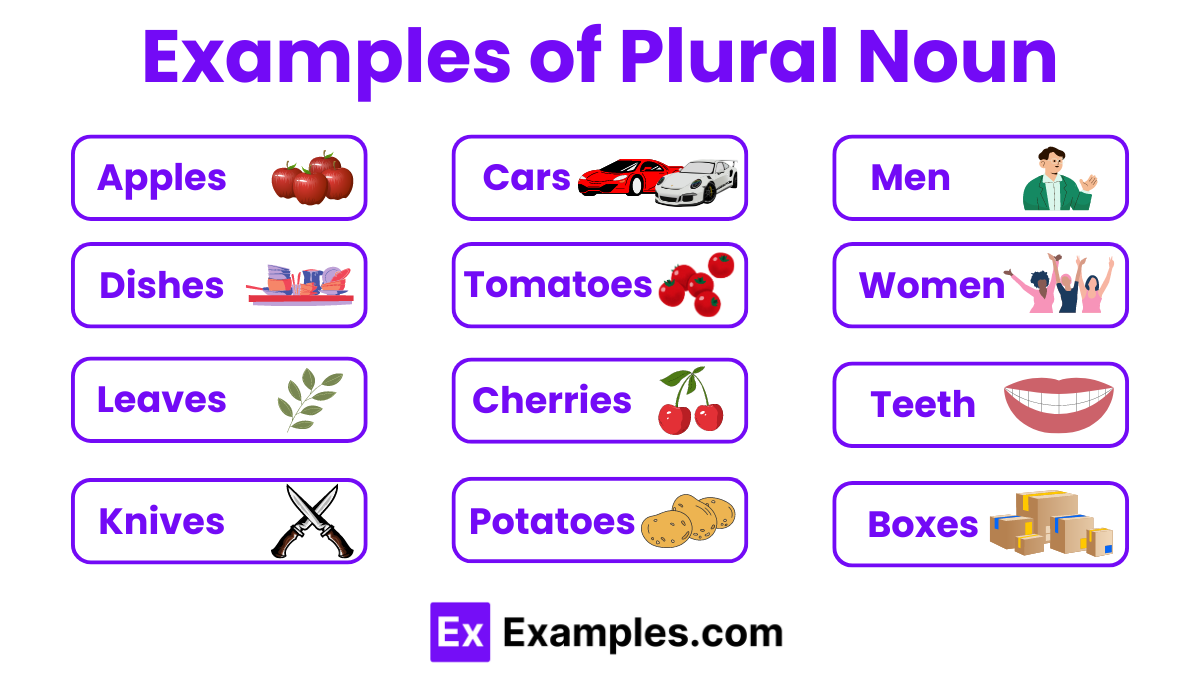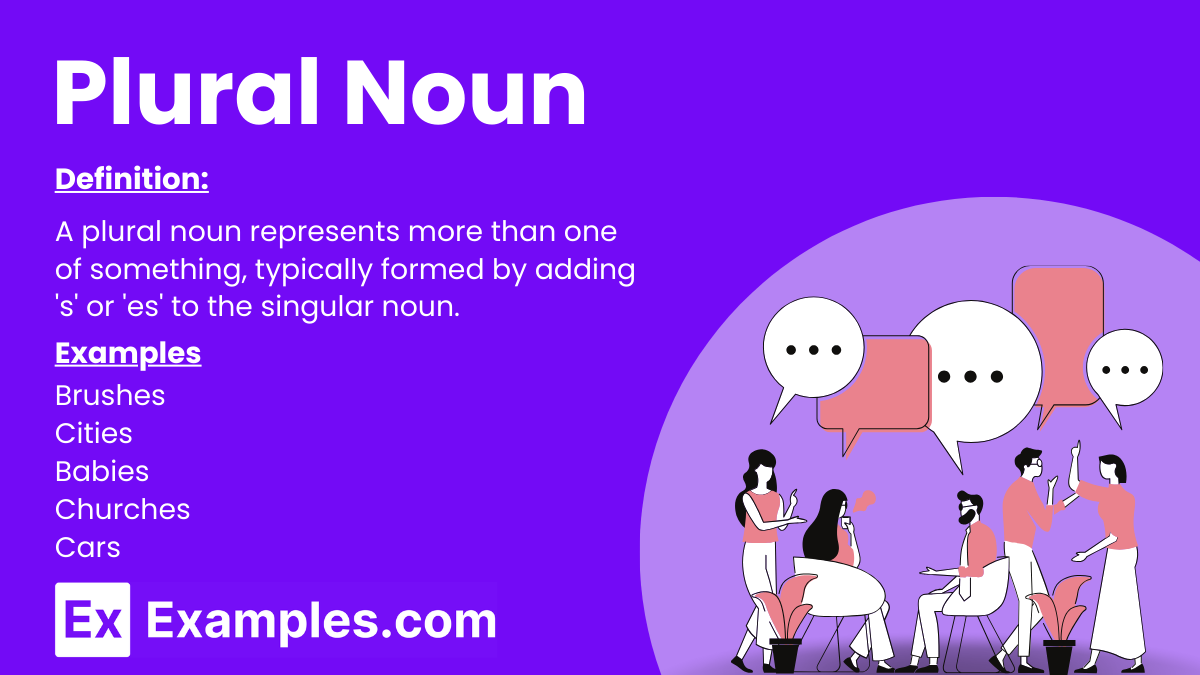Plural Noun
Plural nouns are words that refer to more than one person, place, thing, or idea. Unlike singular nouns that name just one item, plural nouns show that there are multiple items. To make most nouns plural, we add an “s” or “es” at the end. For example, “apple” becomes “apples,” and “box” turns into “boxes.” There are also some irregular nouns that change their spelling completely when they become plural, such as “child” to “children.” Understanding plural nouns helps us talk about more than one object at a time, making our communication clearer and more effective.
What are Plural Nouns?
Types of Plural Nouns
1. Regular Plurals
Most nouns become plural by simply adding an “s” or “es” to the end of the word.
- Example: “book” becomes “books,” and “box” becomes “boxes.”
2. Irregular Plurals
These nouns change their spelling entirely when they become plural, not following the standard rules.
- Example: “man” changes to “men,” and “mouse” changes to “mice.”
3. Plurals with Vowel Changes
Some nouns change their internal vowels instead of their endings when they turn plural.
- Example: “foot” becomes “feet,” and “tooth” becomes “teeth.”
4. Plurals Ending in -y
If a noun ends in a consonant followed by “y,” you change the “y” to “ies” to make it plural. However, if the “y” follows a vowel, you just add “s.”
- Example: “city” becomes “cities,” but “day” becomes “days.”
5. Plurals Ending in -f or -fe
Some nouns ending in “f” or “fe” change to “ves” in the plural form.
- Example: “leaf” becomes “leaves,” and “knife” becomes “knives.”
Examples of Plural Nouns

- Apple – Apples
- Car – Cars
- Brush – Brushes
- City – Cities
- Baby – Babies
- Church – Churches
- Dish – Dishes
- Cherry – Cherries
- Box – Boxes
- Lady – Ladies
- Man – Men
- Woman – Women
- Child – Children
- Tooth – Teeth
- Foot – Feet
- Mouse – Mice
- Goose – Geese
- Leaf – Leaves
- Knife – Knives
- Life – Lives
- Thief – Thieves
- Potato – Potatoes
- Tomato – Tomatoes
- Wife – Wives
- Focus – Foci
- Fungus – Fungi
- Nucleus – Nuclei
- Crisis – Crises
- Phenomenon – Phenomena
- Analysis – Analyses
Plural Noun Rules
1. Standard Plurals
Add an “s” to most singular nouns to form the plural.
2. Nouns Ending in S, X, Z, CH, SH
For nouns ending in s, x, z, ch, or sh, add “es” to make them plural.
3. Nouns Ending in Y
If a noun ends in a consonant before y, change the y to “ies” for the plural. If a vowel precedes the y, simply add “s.”
4. Nouns Ending in F or FE
Change f or fe to “ve” and add “s” to form the plural in some cases.
5. Irregular Plurals
Some nouns change completely in their plural form.
6. Nouns Ending in O
Add “es” to some nouns ending in o, but only add “s” to others, depending on the word.
7. No Change Plurals
Some nouns remain the same in both singular and plural forms.
8. Foreign Nouns
Nouns borrowed from other languages often retain their original plural forms.
How To Use Plural Noun in a Sentence
Using plural nouns correctly in sentences is crucial for clear and effective communication.
Match the Verb
Ensure that the verb in your sentence agrees with the plural noun. Plural nouns require plural verbs.
Use Appropriate Articles
Avoid using the indefinite article “a” or “an” with plural nouns since these articles imply singularity. Use “some” or “the” for plural nouns when needed.
Quantify Correctly
When expressing quantities, make sure that the numeral or quantifier matches the plurality of the noun.
Adjust Pronouns
Pronouns that refer to plural nouns must also be plural.
Consistent Subject-Object Agreement
Keep the subject and object in agreement if they both refer to the same plural noun.
Plural in Adjective Clauses
When describing plural nouns with adjective clauses, ensure that the pronouns and verbs within the clause are plural.
Descriptive Phrases
When using descriptive phrases or prepositional phrases, maintain the plural form throughout.
Tips for Using Plural Nouns
- Master Basic Rules: Learn how to form plurals by adding “s,” “es,” or changing “y” to “ies,” and recognize irregular plural forms.
- Ensure Verb Agreement: Match verbs with plural nouns correctly; plural nouns require plural verbs.
- Memorize Irregular Forms: Keep a list of irregular plural nouns such as “children,” “men,” and “women” for easy reference.
- Use Correct Pronouns: Pair plural nouns with plural pronouns like “they,” “them,” “their,” or “these.”
- Practice with Quantifiers: Use quantifiers that require plural nouns, such as “many,” “few,” and “several.”
- Avoid Double Plurals: Do not add “s” to plural nouns that are already plural, like “data,” “media,” and “criteria.”
- Understand Collective Nouns: Recognize when collective nouns like “team” or “group” are used as singular or plural based on the context.
- Proofread for Consistency: Check your text for consistency in plural noun usage, especially in longer documents.
What is a Plural Proper Noun Examples?
Plural proper nouns are the plural forms of names specific to people, places, or things. Examples include the Smiths, the Rockies, and the Kennedys.
What are the 7 Plural Subject Pronouns?
The seven plural subject pronouns in English are: we, you, they, who, which, ye (archaic), and what (when used as plural).
Is “Us” a Plural Pronoun?
Yes, “us” is a plural pronoun. It is used as the object form in sentences, representing a group including the speaker.
How Do You Form the Plural of Nouns Ending in “Y”?
Change “y” to “ies” if preceded by a consonant (city to cities), but add “s” if a vowel precedes (day to days).
What are Some Common Irregular Plural Nouns?
Common irregular plural nouns include man (men), woman (women), child (children), and mouse (mice).
Can Plural Nouns Ever Be the Same as Singular Nouns?
Yes, some nouns have the same form in both singular and plural, such as sheep, deer, and species.
How Do You Use Plural Nouns with Collective Quantifiers?
Use plural nouns with quantifiers like several, many, and few (e.g., several books, many days, a few apples).
What is the Rule for Plural Nouns with Foreign Origins?
Plural nouns with foreign origins often retain their original plural form, like cacti (from cactus) and indices (from index).
How Do Plurals Work with Hyphenated or Compound Nouns?
For most compound nouns, make the main noun plural (e.g., mothers-in-law, passers-by).
Are There Any Exceptions to Standard Pluralization Rules?
Yes, some nouns have unique plural forms not fitting standard rules, such as oxen and criteria.


